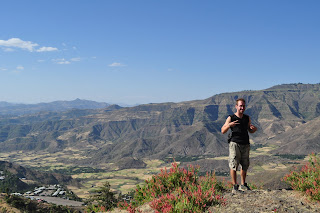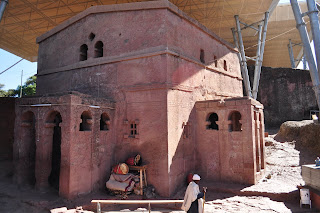Oct. 30th - Nov. 2nd
We left Michelle's at a quarter-to-four. The microbus then picked us up at four on the dot. To our dismay, it then spent the next 30-minutes driving around Bahir Dar is search of some more passengers.
Then, after a pleasant, quick drive to Gashena, we had to talk to a broker who got us seats on another bus to Lalibela. The tarmac road ended there and we made our way across 100 km of mountainous gravel roads. The 2-hour drive was breathtaking. I almost wish it would have taken longer: the rural life unfolding before your eyes and the mountainous landscapes dotted with village huts was magical.

A brief note on Ethiopia's roads. Once touted as some of the most torturous in Africa; but, in the last 5 years, the Chinese have taken large contracts and have been building beautiful, pristine roads all over the country. Even in 2007's Lonely Planet, it states that the journey we had done that morning used to take 2 days. Fifteen years ago, there weren't even any roads to Lalibela and the journey would have taken several days either on foot or by mule. We definitely chose the perfect time to visit!
Once we were dropped off in Lalibela, we commenced our search for accommodations. Up to this point, we had only paid for lodging in that dreadful hotel in Harar, and the fact that most hotels in Lalibela accepted credit cards also contributed to our decision to splurge. We found a beautiful place with a balcony facing some rolling hills and a delightfully hot shower for only 15 dollars a night. This might not seem like much, but in Ethiopia, an ordinary hotel will normally cost you from 2-3 dollars, often including breakfast.
Then, we went to the ticket office and purchased our 5-day passes. Due to the incredible experience on our tours in Harar, we decided that a tour in Lalibela would be the best idea in order to really appreciate and understand what we would be seeing.

By 7 pm, a majority of the locally owned restaurants were closed, so we had to trek all the way back to the ticket office. We chose a small cafe and as we were sitting down, we noticed the distinctive beard of a traveler we had met before. His name was Sven and he was a backpacker from Germany on his way north from South Africa. We had met him in Jinja, Uganda and he had given us some advice regarding places to visit in that country. Due to the theft of my passport, those recommendations were unfortunately and unintentionally discarded.

Sven was having tea with an Austrian guy named Roman who had been doing some WOOFING (working on organic farms) in various African countries and was now just doing some traveling. Roman told a terrifying story of how he was robbed in Dar es Salaam, Tanzania. He had been on a beach with his girlfriend and a local guy who they had met on a bus. It was mid-morning and from out of nowhere, a group of machete-wielding men indiscriminately attacked them. One man thrust his machete at Roman and he put his arm up to protect himself. The machete made contact with his elbow, ripping out a piece of flesh. The Tanzanian they were with received a blow to his head while trying to protect Roman and his girlfriend. Roman stated that this man had probably saved his life. After the attack, the perpetrators made off with whatever valuables the victims had on them, including Roman's passport.
Makes my story seem rather insignificant.
Later that evening, Chris and I went to Bet Maryam church and watched an annual ceremony, performed by well over one-hundred Ethiopian Orthodox priests.

Every Saturday night in the month of October, the Orthodox priests assemble and spend the evening chanting, dancing and praying. They do not stop or take breaks for twelve solid hours. As the 12-hours elapse, you can see the fatigue taking over: the priests collapsing into their seats or desperately leaning on their staffs for rest.

Ethiopian Orthodoxy is very distinct from other Christian sects. Many of their rituals resemble Muslim and Jewish practices more-so than western Christianity. The chanting and dancing conveys a sense of mysticism which is absent from Catholicism and Protestantism. One could even say that these rites and traditions could be seen as paganistic or heretical if contrasted to our typical church services. I must admit that if going to church involved chanting and dancing to the beat of drums, while incense filled the air and worshippers draped themselves in white cloaks; I would definitely be more inclined to be religious.

We stayed and watched this marathon of worship for four hours before we decided to finally call it a night. I could only imagine how those priests must have felt; how devoted they must be; how weary and tired they are; and how weak their legs and vocal cords must be by the end of the night; all for the unwavering veneration of God and Christ. As we slept; they prayed.

I just hope they also prayed for me.
After some of the best sleep I've had in months, Chris and I decided to go for a hike on the way to a mountain-perched church named Asheton Maryam, only we would go for the spectacular views and abstain from entering it. After being chased by a group of children chanting "money", "hello", and the irrelevant "where you go?", we finally found someone who was willing to help us. We would be accompanied by two teenage boys who wanted to practice their English.

We used it as an opportunity to improve our Amharic. It was great to finally see young Ethiopians more interested in conversation and learning than getting tourists to give them money. We spent the whole day with them and enjoyed spectacular views of the countryside.



The following day, our tour guide's name was Abay and his English was quite good. He did a tremendous job of giving us the history and explaining the methods used to create these magnificent stone structures. Lalibela is known for its rock-hewn churches, meaning that the churches are carved out of the rock rather than being constructed from brick or stone. The result is indescribable: each church was carved from top to bottom, creating an organic structure that looks to be one with its environment, rather than contrived or gaudy. The reason these churches were constructed in this way was to keep them hidden from the Muslims who would pass through the area. The result is stunning: Chris and I must have passed right by the most famous church countless times, completely oblivious to its location, before finally being brought there by Abay.
Presently, the only reason one would instantly know the location of one cluster of churches is the horrendous, Italian-built, extraterrestrial-looking roof over the area, which was built to protect the churches from the elements. While I definitely agree that everything possible should be done to preserve these sacred buildings, I definitely think they could have come up with a concept that doesn't look so out of place, or so conflicting.
Lalibela has 11 rock-hewn churches. Bet Maryam, Bet Golgotha, Bet Ghel, Bet Meskel, Bet Mika'el and Bet Medhane Alem forming the first cluster.

And finally, the most famous, Bet Giyorgis or St Georges, having its own separate area.

Each church is unique in design and size. They were constructed in a relatively short amount of time and still remain largely intact. Each church within a cluster is linked by various tunnels and passage-ways. Without a guide, you would surely miss some incredible perspectives.
Out of all the churches, St. Georges was was my favorite: from it's hill-side location, to the iconic cross-shape it bears. The fact that each church was carved rather than built means there is no room for error. Every strike from the hammer and chisel is important, is crucial.

After our tour ended, we asked Abay where we could grab a beer. He then took us to a village bar, if that's what you would call it, for tella, a fermented drink served in tomato cans. Not what we had in mind, but decided it was worth trying. I hoped that the brown liquid with particles floating in it was not an omen to what would be emanating from my ass that evening. Thankfully it wasn't.

We then said goodbye to Abay, grabbed some tea and then had some dinner. We had a great time with Sven and Roman. They were fun to hang out with and I'm sure Abay enjoyed entertaining the four of us.

Just before dusk, we climbed a small hill and watched the sunset. As the sun ducked behind the nearby mountains, Chris asked if I would be interested in staying an extra night. I loved this place, I didn't even hesitate to agree with him.










































